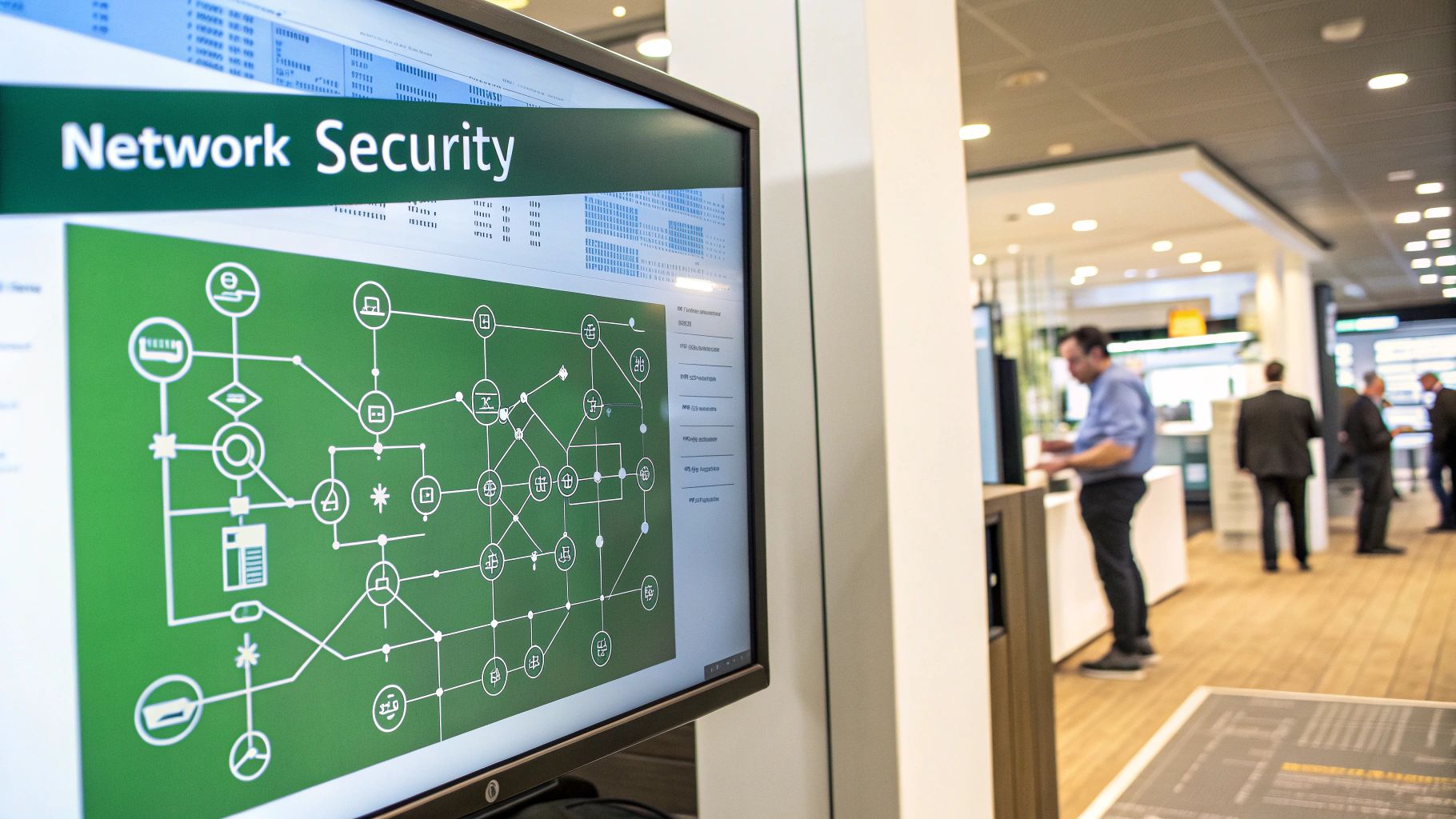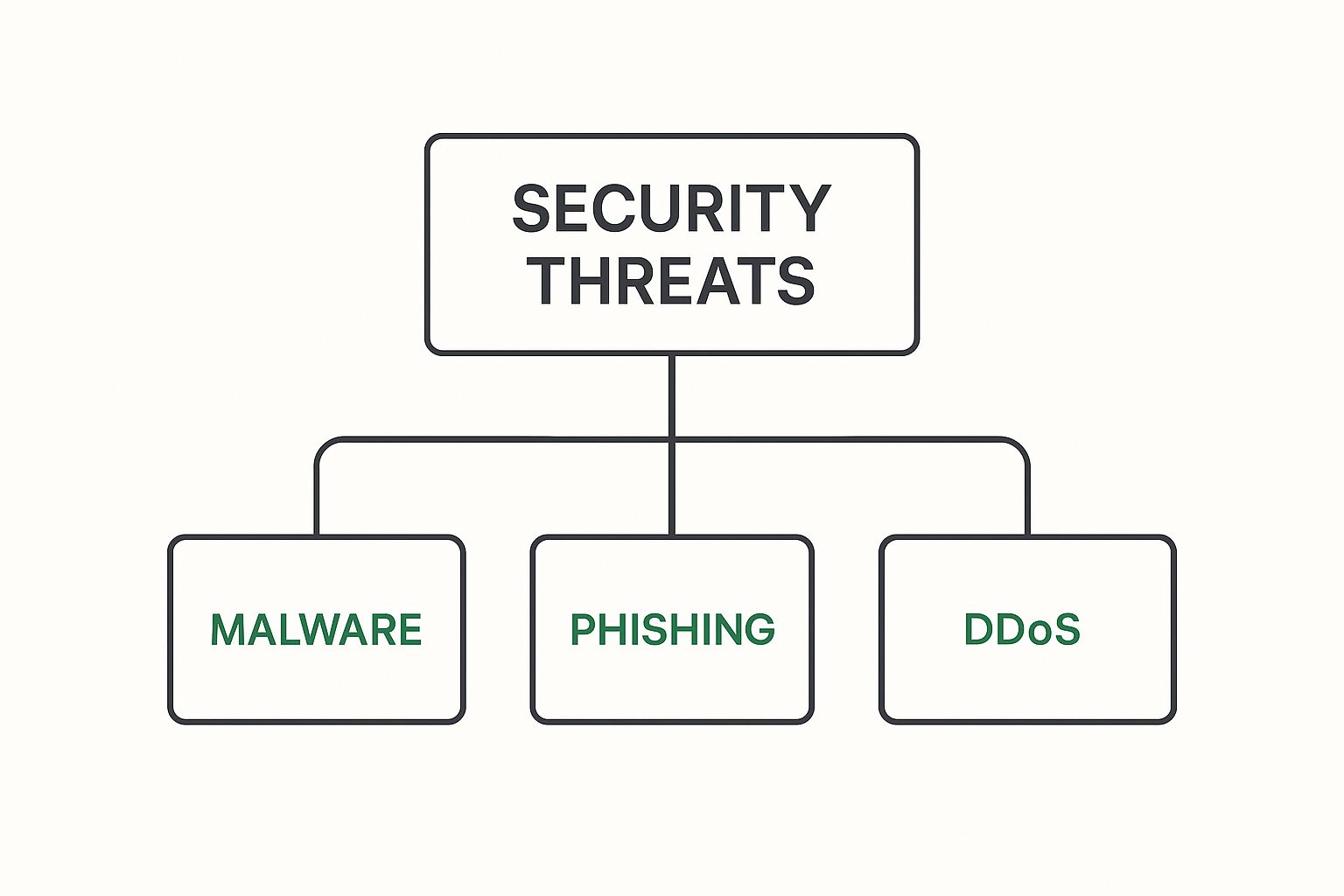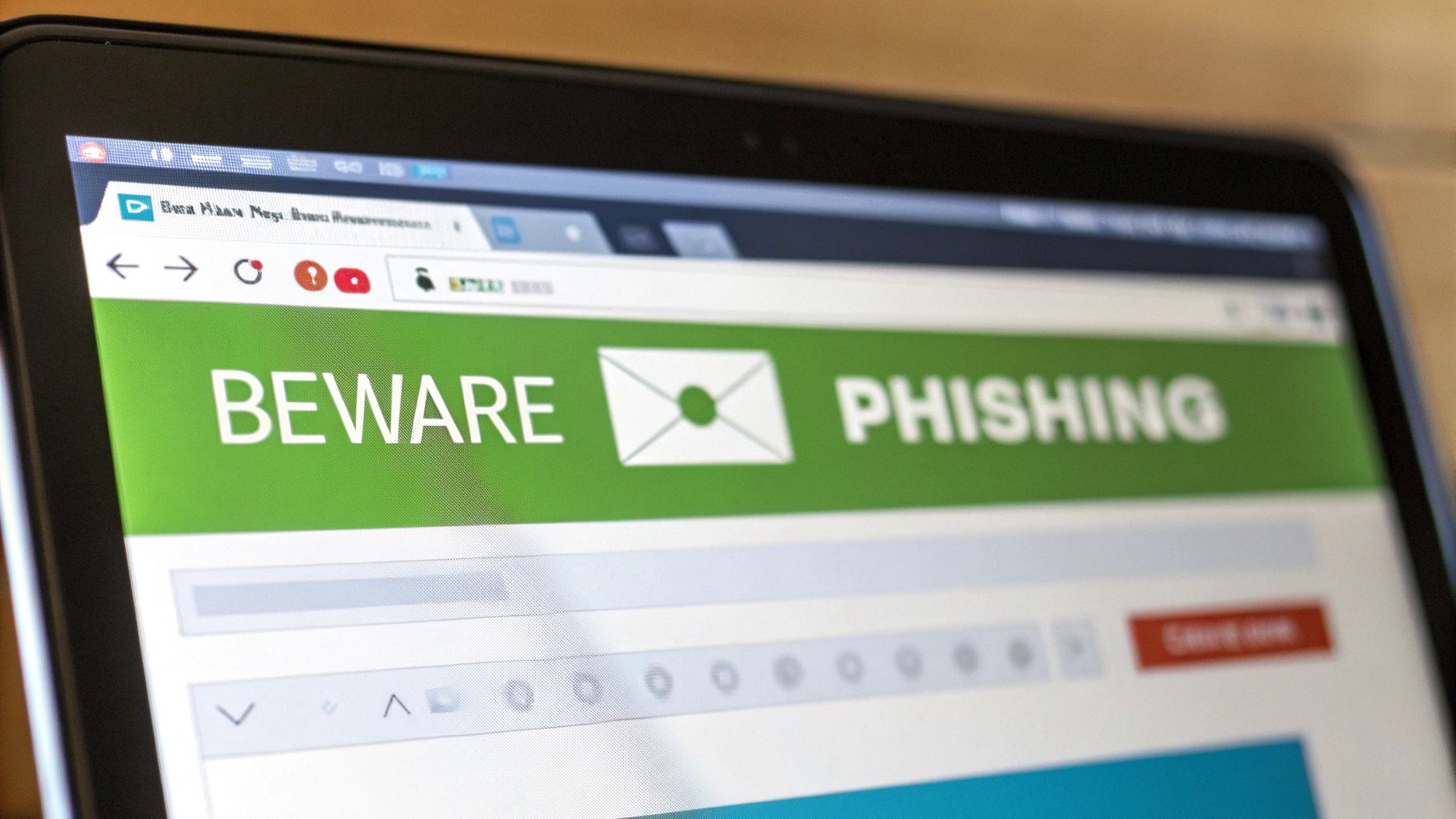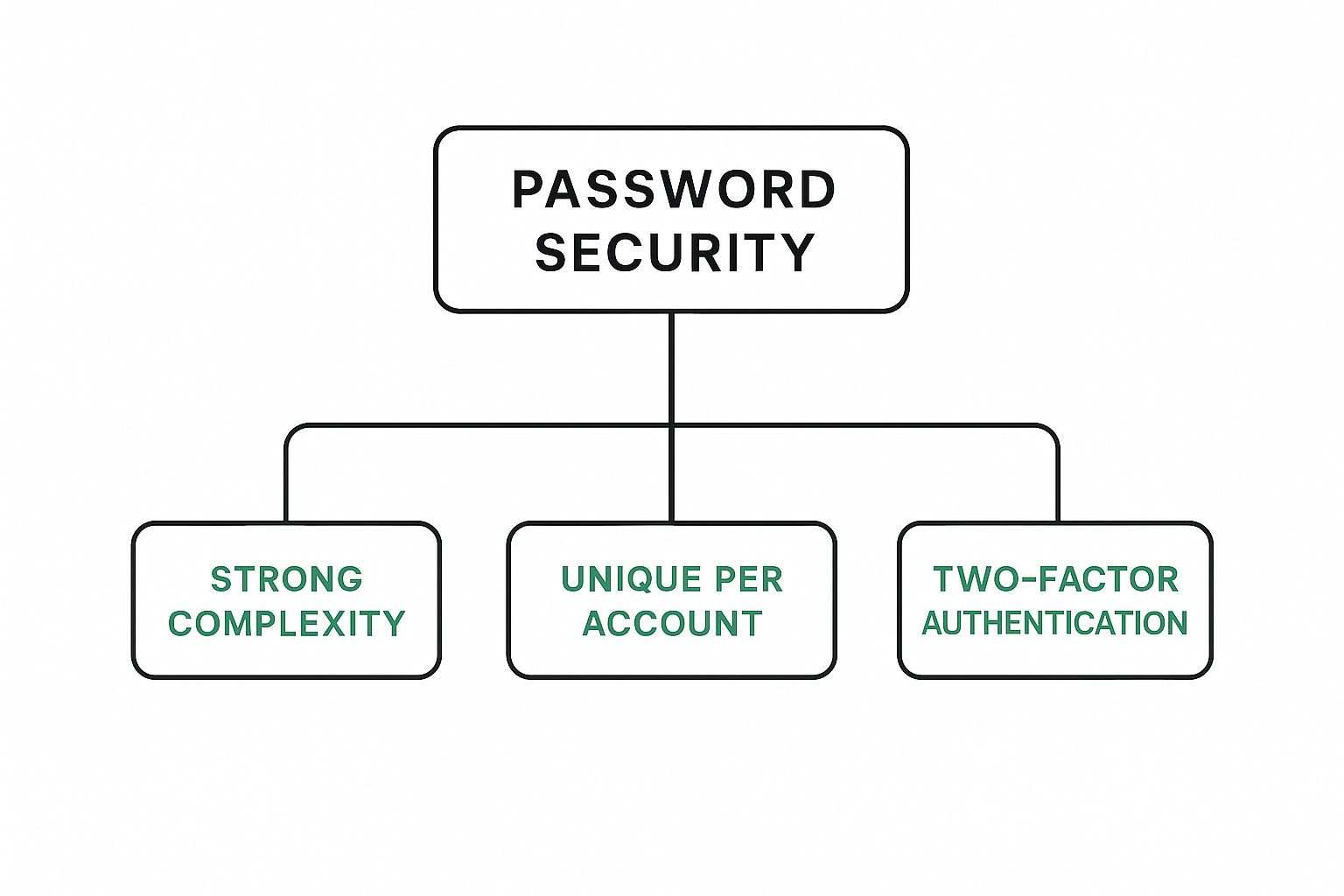At its core, network security is all about protecting your computer network from anyone who shouldn't be there. It's a lot like securing a real-world fortress. You need strong walls (firewalls), vigilant guards checking IDs at the gate (access controls), and secret codes for your messengers (encryption). These are the basic building blocks for creating a safe and trustworthy digital space.
Why Network Security Is Your Digital Fortress

Let's ditch the dry definitions. Think of network security as the ongoing job of building and defending a digital fortress around your most valuable information. The mission is pretty clear: keep the lights on, protect sensitive data, and make absolutely sure that only the right people get inside.
Every single device connected to the internet, whether it's a lone laptop in a home office or a massive data center with thousands of servers, is part of a network. While this connectivity is what makes technology so powerful, it also opens up countless doors for attackers. That's precisely why a solid defense isn't just nice to have—it's essential.
The Core Goal: Protection and Prevention
The real aim here is to build a defense in layers—a system designed to spot and stop attacks before they ever get a chance to do harm. This is not about waiting for something to break and then fixing it. It's about proactively creating an environment that is hostile to threats from the get-go.
The sheer scale of this challenge is reflected in the market. The global network security market is expected to balloon from USD 28.4 billion to USD 117.72 billion over the next decade. This explosive growth just underscores how critical robust security has become for everyone.
This guide is designed to break down these foundational ideas into simple, digestible pieces. We'll get into the "why" behind the technology so you can build a solid understanding and protect your own corner of the digital world.
The point of network security isn’t just to build walls. It’s to create a trusted environment where data can move freely and safely to the right people at the right time.
What You Will Learn
Getting a grip on these fundamentals gives you the power to make smarter decisions about your digital safety. We're going to walk through the essential pillars that hold up any secure network:
- Defensive Technologies: These are your front-line soldiers, including tools like firewalls and encryption.
- Threat Identification: You'll learn how to spot the common culprits, from phishing scams to malware.
- Best Practices: We'll cover the simple, effective habits that can dramatically lower your risk.
It's also important to remember that network security is one piece of a much larger puzzle. To truly see the big picture, it’s worth exploring the broader field of Cybersecurity. Doing so provides the context for how all these different security elements fit and work together.
Understanding the CIA Triad
In network security, pretty much everything boils down to a core framework known as the CIA Triad. No, it’s not a spy agency—it's a model that defines the three essential goals for protecting information: Confidentiality, Integrity, and Availability. Think of it as the bedrock on which every digital fortress is built.
Getting a handle on the triad is crucial because it gives you the why behind every security tool and best practice. Once you understand these objectives, complex tools like firewalls and encryption stop being abstract tech jargon. Instead, you see them for what they are: tools specifically designed to uphold one or more of these foundational principles.
This model is also a constant balancing act for security pros. For example, cranking up confidentiality to the max might make a system clunky and less available for the people who need it. The CIA Triad provides a clear way to talk about these trade-offs and make smart decisions that fit what a person or organization actually needs.
Confidentiality: Keeping Secrets Safe
Confidentiality is all about privacy. It’s the guarantee that information is only seen by the people who are supposed to see it. Simply put, it's about keeping secrets under wraps.
Think about sending a private letter. The sealed envelope is what ensures confidentiality—it stops the mail carrier or anyone else from peeking at the contents. In the digital world, we achieve this with tools like encryption, which scrambles data into an unreadable code, and access controls, which act as digital bouncers, deciding who gets in and who stays out.
When you hear about a hacker stealing a database of customer passwords, that's a direct violation of confidentiality. The whole point is to prevent that kind of unauthorized peek behind the curtain.
Integrity: Ensuring Information Is Trustworthy
Integrity is the promise that your data is accurate and hasn't been messed with. It’s the assurance that the information you're looking at is the real deal, not some altered or corrupted version.
A great real-world example is the tamper-proof seal on a bottle of medicine. That little seal doesn't hide what's inside (that would be confidentiality), but it gives you confidence that the pills haven't been swapped or contaminated. If the seal is broken, you just can't trust the product anymore.
This is absolutely critical for everything from bank transfers to software updates. We rely on technologies like cryptographic hashes and digital signatures to act as these digital seals, letting systems confirm that a file or message hasn't been changed one bit since it was created.
Availability: Access When You Need It
Availability ensures that systems and data are actually accessible to authorized users when they need them. After all, what’s the use of perfectly protected data if you can’t get to it?
It’s like a bank’s ATM. You expect to be able to withdraw your money 24/7. If the machine is always down, it has failed its primary purpose, even if the cash inside is locked up tight. This pillar of security is all about reliability and uptime.
A secure system that is unavailable is, for all practical purposes, useless. Availability is the pillar that ensures security measures don't get in the way of legitimate operations.
Threats to availability are incredibly common and can be devastating. A Distributed Denial of Service (DDoS) attack, for instance, is a brute-force assault on availability. It floods a server with so much junk traffic that it can't respond to real users, effectively taking it offline.
This diagram shows how different threats target these core principles.

As you can see, threats aren't one-size-fits-all; they aim for different vulnerabilities in the triad. Understanding this helps security teams build a layered defense that protects all three pillars at once.
To bring it all together, here’s a quick summary of how these principles play out in the real world.
The CIA Triad in Action
| Pillar | Core Principle | Real-World Analogy | Common Technologies |
|---|---|---|---|
| Confidentiality | Preventing unauthorized disclosure of information. | A sealed, private letter. | Encryption, Access Control Lists (ACLs), Two-Factor Authentication (2FA) |
| Integrity | Ensuring data is accurate and unaltered. | A tamper-proof seal on a product. | Cryptographic Hashes (e.g., SHA-256), Digital Signatures, Version Control |
| Availability | Guaranteeing reliable access to data for authorized users. | An ATM that is always online and functional. | Redundant Systems, Load Balancers, DDoS Mitigation Services |
This table shows that while the concepts are distinct, the technologies we use often work together to provide a comprehensive security posture. A strong defense addresses all three pillars, not just one or two.
Your Digital Defense Toolkit

Now that we've covered the strategic side of things, it’s time to get our hands dirty with the actual tools that form the layers of your digital defense. These technologies are where the principles of the CIA Triad come to life, with each one built to enforce confidentiality, integrity, or availability.
Think of it like outfitting a fortress. You need more than just a strong wall; you need guards, lookouts, secret passages, and coded messages. Each piece of your security toolkit plays a specific role, and they all work together to create a formidable barrier. Let's meet the crew.
Firewalls: The Digital Gatekeepers
The firewall is one of the oldest and most essential tools in the box. Its job is simple in theory but incredibly powerful in practice: it's the bouncer standing at every entry and exit point of your network, meticulously checking every piece of data, or "packet," that tries to pass.
Based on a set of rules you define, the firewall makes a simple decision: allow or deny. You might set a rule to block traffic from a known bad neighborhood on the internet or only allow web traffic through a specific door (port). This control stops a massive number of attacks before they ever get a chance to knock on your server's door.
A firewall is your non-negotiable first line of defense. It creates a controlled perimeter between your trusted internal network and the untrusted chaos of the public internet.
The key is its strategic placement. A firewall acts as a choke point, forcing all traffic to pass through its inspection before it can go anywhere else.

This setup is the absolute foundation for establishing a secure network boundary.
Intrusion Detection Systems: The Silent Alarms
A firewall is great at stopping threats based on known rules, but what about something new or sneaky that slips by? That's where an Intrusion Detection System (IDS) comes into play. Think of it as a silent alarm system for your network. It doesn't actually block anything on its own; instead, it watches everything.
An IDS constantly monitors network activity for suspicious patterns. If it spots something that looks like an attack—like a sudden flood of connection attempts or unusual data transfers—it logs the event and fires off an alert to a security admin. This gives you a heads-up to investigate before real damage is done. Its more proactive cousin, the Intrusion Prevention System (IPS), can even step in and block the suspicious traffic automatically.
Virtual Private Networks: The Armored Car for Your Data
Every time you connect to public Wi-Fi at a coffee shop or airport, your data is traveling out in the open. A Virtual Private Network (VPN) is the solution. It creates a secure, private tunnel for your information right through the middle of that public network.
Here's how it works its magic:
- Authentication: Your device securely connects to the VPN server.
- Encryption: All data leaving your device is scrambled into an unreadable code.
- Tunneling: This scrambled data travels through the secure tunnel to the VPN server.
- Decryption: The server unscrambles your data and sends it to its final destination online.
It's like putting your mail inside a locked, armored car for the entire journey. Even if someone manages to intercept the vehicle, they can't get inside to read the letters. It’s an essential tool for protecting confidentiality and keeping your online activity private.
Encryption: The Art of Secret Codes
Encryption is the secret sauce that makes technologies like VPNs possible. At its core, encryption is simply the process of scrambling data into a useless, unreadable format using a complex mathematical algorithm. This scrambled mess, called ciphertext, is worthless to anyone who doesn't have the specific "key" to unlock it.
There are two main flavors of encryption:
- Symmetric Encryption: Uses a single key to both lock and unlock the data. It's incredibly fast, but you have to find a secure way to share that one key.
- Asymmetric Encryption: Uses a pair of keys. A public key, which you can share with anyone, is used to lock the data. A corresponding private key, which you guard with your life, is the only thing that can unlock it.
This technology is the bedrock of secure online banking, e-commerce, and private messaging. Without it, our most sensitive information would be an open book for anyone to read.
The growing reliance on these tools explains why worldwide spending on cybersecurity is projected to hit USD 212 billion in the coming years. If you're interested in the business side of security, you can discover more insights about cybersecurity market trends and the investment surge driving it.
2. Recognizing Common Network Threats
To build a solid defense, you first need to know what you’re up against. Think of it like this: you can't secure a castle without understanding how an enemy might try to get in—whether by storming the gate, scaling the walls, or sneaking through a hidden tunnel.
Let's break down the most common tactics attackers use to breach our digital walls. Getting a handle on these threats is the first real step toward protecting yourself and your network.
Malware: The Uninvited Guest
Malware, which is just short for "malicious software," is any piece of code designed to worm its way into your system and cause harm. It’s the digital equivalent of a burglar jimmying a window to get inside your house.
Once it's in, malware can do all sorts of nasty things, from quietly stealing your passwords to locking up your entire hard drive. It comes in a few common flavors:
- Viruses: These pesky programs latch onto clean files. When you open that file, the virus activates and spreads to other files on your computer, just like a biological virus.
- Worms: Worms are more independent. They don't need to attach to a file; instead, they exploit vulnerabilities in a network to replicate and travel from one machine to another, often creating massive, fast-spreading infections.
- Ransomware: This is straight-up digital extortion. Ransomware encrypts all your important files—documents, photos, everything—and demands you pay a ransom to get the decryption key. It's one of the most destructive and costly threats out there today.
The important thing to remember is that most malware needs a little help from you to get started, like clicking a shady link or opening a suspicious email attachment.
Phishing: The Digital Con Artist
Phishing isn't about exploiting software; it’s about exploiting human psychology. It’s a con game. You get an email that looks like it’s from your bank, Amazon, or even your boss, urging you to click a link to "verify your account" or "review an urgent invoice."
These scams create a false sense of urgency or fear to trick you into acting without thinking. The attacker is "fishing" for your credentials—passwords, credit card numbers, you name it. A more targeted and dangerous version is spear phishing, where the attacker researches you specifically and crafts a personalized message that’s much harder to spot as a fake.
Ultimately, phishing aims to get you to hand over the keys to your digital kingdom voluntarily. Human error remains one of the biggest vulnerabilities in any security system, making this a critical area to understand for your guide to modern data breach prevention.
Comparing Common Cyber Threats
To help you distinguish between these threats at a glance, here’s a quick breakdown of their goals and how they typically operate.
| Threat Type | Primary Goal | Common Delivery Method |
|---|---|---|
| Malware | Infiltrate, damage, or steal data from a system. | Malicious email attachments, infected downloads, compromised websites. |
| Phishing | Trick the user into revealing sensitive information. | Deceptive emails, text messages (smishing), or social media messages. |
| Ransomware | Encrypt data and extort money for its release. | Often delivered via phishing emails or exploiting software vulnerabilities. |
| DoS/DDoS | Overwhelm a service to make it unavailable. | A flood of traffic from one or many compromised computers (botnet). |
Understanding these distinctions is key, as defending against a con artist requires a different strategy than defending against a battering ram.
Denial of Service Attacks: The Digital Traffic Jam
A Denial-of-Service (DoS) attack is less subtle and more of a brute-force maneuver. Its goal is simple: to knock a website or service offline by flooding it with more traffic than it can possibly handle.
Imagine a single road leading to a popular store. A DoS attack is like sending thousands of empty cars to create a massive traffic jam, completely blocking the road so that real customers can't get through.
Things get even uglier with a Distributed Denial-of-Service (DDoS) attack. Instead of one source, the attack traffic comes from thousands of hacked computers around the world—a "botnet"—making it incredibly difficult to stop.
A DoS attack isn't about stealing your information. It's about disruption. For any online business, being forced offline means lost revenue and a serious blow to its reputation.
By getting familiar with these three threats—malware, phishing, and DoS attacks—you're no longer just a potential victim. You're starting to think like a defender, which is the most important skill you can have.
Essential Security Best Practices

Knowing the threats and the tools to counter them is a great start. But that knowledge is only powerful when you put it into practice. This is where we shift from theory to action, focusing on the core habits and policies that create a genuinely strong security posture.
These best practices are the day-to-day routines that stop most attacks in their tracks. They are the practical application of network security fundamentals, turning a reactive, wait-and-see defense into a proactive one.
Fortify Your Access Points
The most common way attackers get in is by simply waltzing through the front door with stolen or weak credentials. That makes strengthening your access points the single most effective thing you can do to boost security right away. It all begins with the non-negotiable foundation of strong passwords.
A strong password isn't just complex—it's long and, crucially, unique for every single service you use. Reusing passwords is like having one key for your house, your car, and your office. If a thief gets that key, they get everything.
To really lock things down, you have to implement Multi-Factor Authentication (MFA) wherever it’s offered. Think of MFA as needing a key (your password) and a secret code sent to your phone to open a vault. Even if an attacker manages to steal your password, they're stopped cold because they don't have that second piece of the puzzle. It’s one of the simplest and most powerful security upgrades you can make.
"Passwords are the keys to your digital kingdom. Multi-Factor Authentication is the trusted guard standing at the gate who asks for a second form of ID."
This two-layer approach makes it exponentially harder for anyone to get in who shouldn't be there, effectively neutralizing the massive threat of stolen passwords.
Practice Proactive Maintenance
Think of your software and systems as the walls of a digital fortress. Over time, attackers discover tiny cracks and weaknesses—we call them vulnerabilities—that they can exploit to slip inside. Regular software updates are the masons who find and patch those holes before an invasion can happen.
Ignoring updates is like leaving a side door unlocked for anyone to find. A staggering number of security breaches are caused by attackers exploiting well-known issues for which a fix was already available.
Here’s a simple routine to get into:
- Enable Automatic Updates: For your operating system, web browser, and other critical software, just turn on automatic updates. You'll always have the latest, most secure version without having to think about it.
- Regularly Review Applications: Every so often, take a look at the software you have installed and uninstall anything you don't use anymore. Every program on your system is another potential entry point; reducing this "attack surface" is a smart move.
- Stay Informed: For crucial business systems, it’s worth subscribing to vendor security newsletters or alerts. They’ll notify you of major vulnerabilities and tell you how to fix them.
This commitment to maintenance is a core part of modern network security. The growing complexity of cyber threats is driving huge investments in this space. In the United States alone, the network security market is projected to grow from USD 5.3 billion to USD 11.6 billion within a decade—a clear sign of how critical this is.
Implement the Principle of Least Privilege
One of the most powerful concepts in security is also one of the simplest: the Principle of Least Privilege (PoLP). At its core, this principle says that any user, program, or process should only have the bare-minimum permissions needed to do its job. Nothing more.
In the real world, this means not giving every employee administrator access to the whole network. Someone in marketing doesn't need to see financial records, and the accounting software has no business modifying core system files.
By restricting access this way, you dramatically limit the potential damage if an account is ever compromised. If a hacker gets control of a user's account, they are effectively trapped, unable to move across the network to steal more valuable data. It's a simple idea that transforms your security culture from one of open access to one of deliberate, intentional control.
Building this kind of security-first culture often comes down to continuous learning and reinforcement. To get your team on board, you might want to look into https://typewire.com/blog/read/2025-09-13-your-guide-to-information-security-awareness-training. For more hands-on steps to protect your online assets, these website security best practices are a great resource.
Your Path to a Secure Digital Future
Getting a handle on network security isn't a one-and-done task. It's an ongoing commitment, a continuous cycle of learning and adapting. Think of that digital fortress we talked about one last time. You've built the walls, posted the guards, and established the secret handshakes. But the world outside is always in flux—new threats and clever tactics pop up constantly.
Real security isn't about building a fortress and walking away. It's a living, breathing process of vigilance, adaptation, and proactive upkeep. You're always patching the walls, updating the guard duty roster, and training your sentinels for what's next. This dedication to layered defense is what makes a network truly resilient.
From Knowledge to Action
The whole point of this is to feel empowered, not overwhelmed. Now that you understand the core concepts, from the CIA Triad to the most common threats, you have the context to make smart, informed decisions.
This foundation lets you shift from a reactive stance to a proactive one. For instance, instead of waiting for a breach, you can build a security model that assumes threats are already inside the walls. This is the core idea behind modern security frameworks, and learning what is Zero Trust security and why it matters is the perfect next step on your journey.
A secure network isn’t one that’s impossible to attack; it’s one that’s resilient. It can spot threats, withstand the hit, and recover quickly because its defenses are deep and always evolving.
In the end, every security tool you deploy and every best practice you follow makes the digital world a little bit safer for everyone. By taking these steps, you're not just guarding your own data—you're reinforcing the integrity of our connected world. That vigilant, informed approach is how we all build a more secure future, together.
Common Questions Answered
Even after you get the hang of the basics, you're bound to have a few lingering questions. Let's tackle some of the most common ones that come up and connect the dots to how this all works in the real world.
What’s the Single Most Important Thing for a Beginner to Learn?
If I had to pick just one concept to start with, it would be the Principle of Least Privilege. It’s a beautifully simple idea with massive security payoffs.
The concept is this: any person or piece of software should only have the absolute minimum permissions required to do its job, and nothing more. Think of it like giving a houseguest a key to the guest room, not a master key to the whole house.
When you apply this thinking, you stop handing out admin rights to everyone by default. This single change drastically shrinks your attack surface. If an account gets compromised, the intruder is stuck in a tiny, walled-off area instead of having the keys to the entire kingdom.
Adopting the Principle of Least Privilege shifts your security posture from being reactive to proactive. You're building a network that is fundamentally stronger from the ground up.
How Do Physical and Network Security Actually Connect?
They’re two sides of the same coin—completely intertwined. You could have the most advanced firewall on the planet, but it’s worthless if someone can just walk into your server room and walk out with a server.
Real security means protecting both the physical and the digital.
Imagine a data center. Controlling who gets in the door with a keycard is physical security. But protecting the digital logs of who used those keycards and when—that’s network security. You can’t have one without the other, otherwise you leave huge, dangerous gaps in your defenses.
Is a Firewall All I Really Need to Be Secure?
Absolutely not. A firewall is a fantastic and essential first line of defense, but it's just one piece of the puzzle. Relying on it alone is like locking your front door but leaving all the windows wide open.
Modern security is all about "defense-in-depth," which is just a way of saying you need multiple layers of protection.
A firewall is great at blocking unwanted traffic from the outside, but it’s not going to stop an employee from getting tricked by a clever phishing email and downloading malware. The malicious file comes from a seemingly legitimate source, so the firewall lets it right through.
That’s why you need to pair your firewall with other critical tools, like:
- Anti-malware software on all your devices to catch and neutralize malicious code.
- An Intrusion Detection System (IDS) to act as a burglar alarm inside your network, spotting suspicious behavior.
- Regular security awareness training to teach your team how to spot and avoid threats before they click on them.
Protecting your network is one thing, but your private communications need just as much attention. Typewire offers secure, private email hosting that puts you in control, completely free from snooping and ads. You can start a free trial and see what a truly private inbox feels like. Learn more at https://typewire.com.






